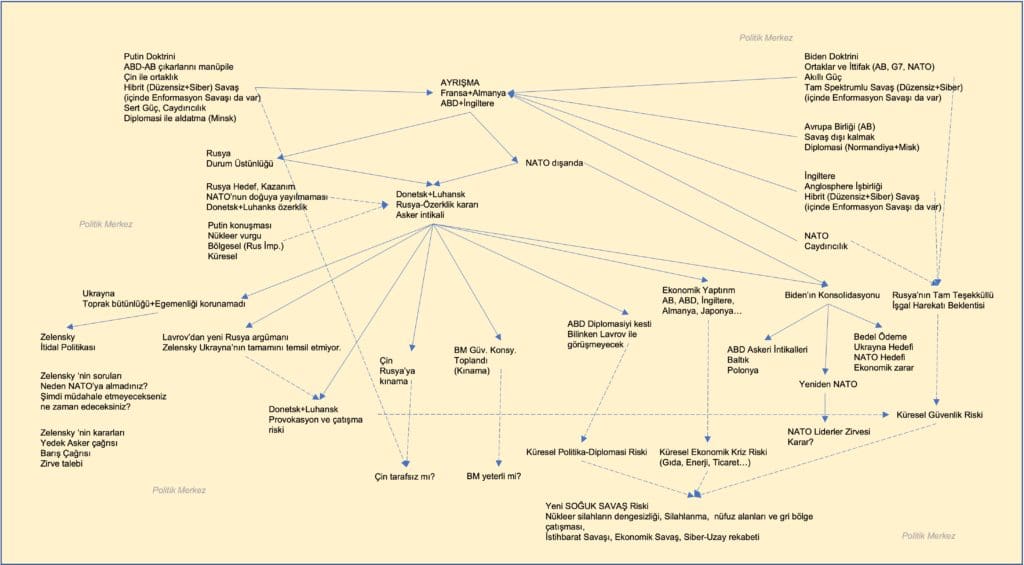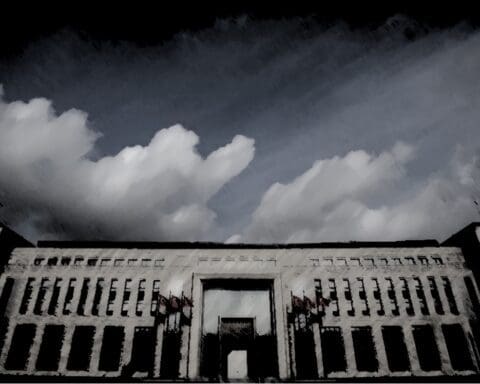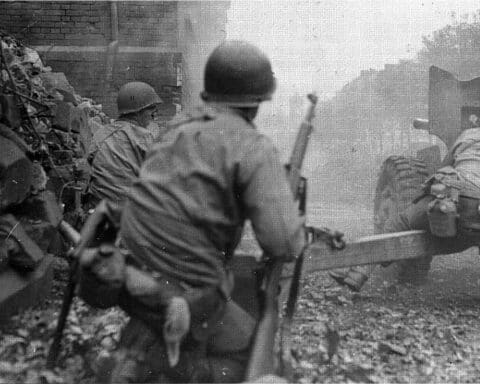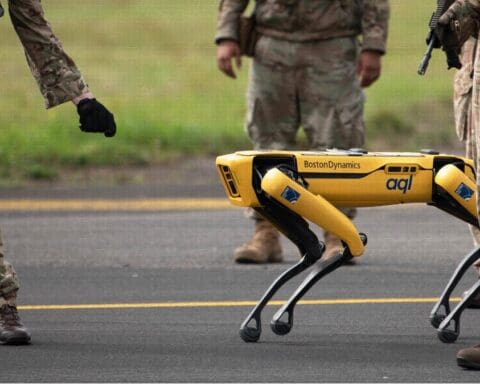The Ukraine crisis and the security of Europe are intertwined. The most important topic here is the nuclear threat. It is not possible for us to accurately explain the positions of neither the US and Russia nor other parties without understanding the interrelationship of important issues of this strategic value.
The process that started with the Helsinki 1975 Agreement on the European security architecture gained momentum with the fall of the Berlin Wall in 1989. European security was riveted with the OSCE.
In the period of “detente” that affected Europe in the 1970s, the Western Bloc’s proposal to start negotiations on “mutual and balanced force reductions” was accepted by the Eastern Bloc, and in parallel with this, as a result of the negotiations that started in Helsinki in 1973, the Helsinki Final Act was signed. The European Security and Cooperation Conference process started with the signing of 33 European countries, USA and Canada in 1975.
With the 1990 Paris Charter, which constituted the political beginning of the post-Cold War era and symbolized an important turning point in the Helsinki process, it was decided that the need for the institutionalization of the Conference on Security and Cooperation in Europe (CSCE) through political consultation mechanisms and a series of permanent bodies emerged, 1992 Helsinki Summit. The foundations of institutions and organizations that are still functional today were laid in. At the 1994 Budapest Summit, the CSCE was transformed into an international organization and was renamed the Organization for Security and Cooperation in Europe (OSCE).
The multidimensional and complex nature of the threats encountered in the twenty-first century necessitated the efforts of the OSCE to improve the possibilities and capabilities of combating these threats in the 2000s as well. In this respect, the “OSCE Strategy for the Threats to Security and Stability in the Twenty-First Century” was adopted at the Maastricht Ministerial Council in 2003, and with the declaration titled “Towards a Security Community” adopted at the 2010 Astana Summit, the goal of building a security community in the OSCE geography was expressed. A vision based on the principles of comprehensive and collaborative security and the indivisibility of security is envisaged.
The year 2015, which coincides with the 40th anniversary of the signing of the Helsinki Final Act, was set as the target for the creation of “building blocks” for the construction of the security community, and forward-looking, constructive, result-oriented and informal dialogue was initiated between the participating states with the “Helsinki+40” process. With the effect of the Ukraine crisis that started in 2014, although it was not possible to accept a “building block” document in 2015, the “Helsinki+40” process was beneficial in terms of enabling structured discussions on the future of the Organization.
After nearly 10 years of difficult negotiations, the United States and the Soviet Union signed the Strategic Arms Reduction Treaty (START) on July 31, 1991. Five months later, the Soviet Union dissolved and four independent states with strategic nuclear weapons stepped in (Belarus, Kazakhstan, Russia and Ukraine).
With the expectation that the agreement will enter into force within a few months of its signing, work on the technical characteristic definitions of strategic ballistic missiles and the distinguishability definitions of heavy bombers began in September 1991 and was completed in March 1992. Both sides began destroying their intercontinental ballistic missiles (ICBMs). Also included are launchers, submarine-launched ballistic missiles (SLBMs), and heavy bombers long before START’s anticipated force entry date.
With the Lisbon Protocol of the START-I Treaty signed on May 23, 1992, Belarus, Kazakhstan, Russia and Ukraine became parties to the START-I Treaty as the legal successors of the Soviet Union.
On December 5, 1994, the parties exchanged ratifications at the Budapest summit. START was to be for a period of 15 years and could be extended for consecutive five-year terms by agreement between the parties. All nuclear warheads have been removed from Belarus, Kazakhstan and Ukraine. On December 5, 2001, the United States and the Russian Federation successfully achieved START-I levels of 6,000 warheads deployed. Kazakhstan, Belarus, and Ukraine have completely eliminated or displaced nuclear arsenals left over from the Soviet Union.
Within seven years from the date of entry into force of the agreement, the reduction of strategic offensive weapons to equal total levels, which was carried out in three stages, continued. At the end of each stage, specific, equal intermediate levels have been set for the agreed upon categories of strategic offensive weapons.
In the Lisbon Protocol and related documents, Belarus, Kazakhstan and Ukraine, as non-nuclear weapon states, committed to accede to the Nuclear Non-Proliferation Treaty (NPT) as soon as possible and to eliminate all nuclear weapons and all strategic offensive weapons. START imposes bans on positions, training, testing and modernization, in addition to eliminating missiles, their launchers and bombers. When the reductions were completed in 2001, Belarus, Kazakhstan, and Ukraine would no longer have strategic nuclear powers, and the strategic arsenals of the United States and the former Soviet Union would have been reduced by 30-40 percent. It was complied with.
The end of the Cold War era has created new opportunities to overcome the economic division of Europe. Energy has formed one of the most notable sectors in the convergence phase between the East and the West. The mutual interests of both sides facilitated cooperation in this field. While Western European countries, which are dependent on foreign countries in terms of energy, see their interests in providing safe oil and gas supply from the producing Commonwealth of Independent States (CIS) countries and thus reducing their dependence on Middle Eastern hydrocarbon resources, Russia and the post-USSR countries have invested in investments that will increase their energy production potential that can be provided by Western large companies. was in need. This union of interests paved the way for the European Energy Charter Declaration in 1991. The aforementioned declaration determined that cooperation in the field of energy should be based on free market rules, transparent and competitive foundations.
As a result of the negotiations carried out in this cooperation environment, 50 countries and the EU signed the Energy Charter Treaty (ECT) in Lisbon on 17 December 1994. This agreement has realized international codification for the signatory countries in the fields of energy trade, energy investments of companies, transit issues, conflict resolution and cooperation on energy adequacy.
ECT is the first agreement that brings together the countries established after the collapse of the USSR, the Central and Eastern European countries that were previously managed with a planned economy, and the OECD countries (excluding the USA, Canada, Mexico and New Zealand).
The Budapest Memorandum of Security Assurance refers to the political agreement signed by the signatory parties at the OSCE conference in Budapest, Hungary on 5 December 1994 to provide “security guarantees” regarding the accession of Belarus, Kazakhstan and Ukraine to the Non-Proliferation Treaty. The Nuclear Weapons Agreement was originally signed by the three nuclear powers: Russia, Britain, and the United States. China and France gave somewhat weaker individual assurances in separate documents.
The memorandum contained security guarantees against threats to the territorial integrity or political independence of Ukraine, Belarus and Kazakhstan or the use of force.
Between 1994-96 Belarus, Kazakhstan and Ukraine gave up nuclear weapons capabilities. By that time, Ukraine had the third largest nuclear weapons capacity in the world. Even during the Cold War, Ukraine had no operational control over the use of weapons, although it had physical strength. Russia alone controlled the codes and lines of communication needed to operate nuclear weapons.
In 2009, Russia and the United States issued a joint statement that the security guarantees of the memorandum would be respected after the end of the START Treaty.
According to the memorandum, Russia, the USA and the UK agreed that Belarus, Kazakhstan and Ukraine were parties to the Nuclear Non-Proliferation Treaty and that they had de facto abandoned their nuclear arsenals to Russia, and they committed to:
- Respect the independence and sovereignty of Belarus, Kazakhstan and Ukraine at the existing borders.
- Avoid threats or use of force against Belarus, Kazakhstan and Ukraine.
- Avoid using economic pressure on Belarus, Kazakhstan and Ukraine to influence their policies.
- Request immediate action by the Security Council to provide assistance to Belarus, Kazakhstan and Ukraine “if they are the victim of or the object of a threat of attack using nuclear weapons”.
- Avoid using nuclear weapons against Belarus, Kazakhstan and Ukraine.
- If there are problems with these commitments, use the opportunities to consult with each other.
Russia, the USA and the UK have made a promise to Ukraine. The agreement also included security guarantees against threats to Ukraine’s territorial integrity or political independence or the use of force by Russia and the signatory states.
In fact, in that agreement, it is emphasized that “the signatory countries will not resort to a threat or use of force against Ukraine and that they will activate the United Nations Security Council (UNSC) in case Ukraine encounters a threat or aggression.”
The “Agreement on Measures for the Further Reduction and Limitation of Strategic Assault Weapons” between the United States and the Russian Federation, also known as the “New START Agreement”, covers all deployed intercontinental range nuclear weapons of Russia. The United States and Russia agreed to extend the agreement until February 4, 2026.
What are the strategic attack limits? The new START Agreement entered into force on February 5, 2011. Accordingly, the United States and Russia have seven years to meet the treaty’s central limits on strategic offensive weapons, and are then obligated to maintain these limits as long as the treaty remains in effect.
Both the United States and Russia met the central limits of the New START Treaty until February 5, 2018, and have remained at or below that boundary ever since.
The new START limits all of Russia’s deployed intercontinental range nuclear weapons, including every Russian nuclear warhead loaded on an intercontinental-range ballistic missile that can reach the United States in about 30 minutes. It also limits the deployed Avangard and the Sarmat under development, two of the most operationally viable of Russia’s new long-range nuclear weapons capable of reaching the United States. The expansion of the new START ensures that there are verifiable limits on the fulcrum of Russian nuclear weapons capable of reaching the US homeland over the next five years. As of the most recent data exchange on September 1, 2020, Russia has declared 1,447 strategic warheads deployed. Russia has the capacity to place more than 1,550 warheads on heavy bombers, as well as its modernized ICBMs and SLBMs, but this is restricted by New START.
Ukraine, which is among the countries that gained its independence after the Cold War ended in 1991, was one of the 3 largest nuclear powers in the world. In the negotiations that started with the reduction of nuclear weapons, the Kiev Government transferred 1,900 strategic and 2,650 to 4,200 tactical nuclear weapons to Moscow “on the condition of trust”.
In February 2014, Russian forces captured or blockaded several airports and other strategic locations across Crimea. The troops were subordinate to the Russian Black Sea Fleet stationed in Crimea, which violated Russia’s Budapest Memorandum. The Russian Ministry of Foreign Affairs confirmed the movement of the armored units of the Black Sea Fleet in Crimea, but claimed that they acted within the scope of various agreements between the two countries. Crimea should join it. Russia announced that the referendums were held by “local powers”. On March 16, Russia annexed Crimea, and Ukraine vigorously protested the action on the grounds that it violated Article 1 of the Budapest Memorandum.
In response to the crisis, the Ukrainian Parliament asked the signatories to reaffirm their commitment to the principles contained in the political agreement and to consult with Ukraine to de-escalate tensions.
The Ministry of Temporarily Occupied Territories and Internally Displaced Persons is a ministry in Ukraine, which was officially established on April 20, 2016 to manage the occupied regions of Donetsk, Luhansk and Crimea, which were affected by the Russian military intervention in 2014.
On March 24, 2014, Canadian Prime Minister Stephen Harper led the G7 partners in a special meeting during the Nuclear Security Summit in The Hague to partially suspend Russia’s membership due to Russia’s violation of the Budapest Memorandum. He said Ukraine gave up its nuclear weapons “on the basis of a clear Russian guarantee of territorial integrity”. By violating that guarantee, President Putin provided a justification for those who needed a little more elsewhere. He armed the separatists. Harper also expressed his support for Ukraine, saying he would work with the new Ukrainian government on a free trade agreement.
After the annexation of Crimea by Russia in 2014, the G7 countries (Canada, France, Germany, Italy, Japan, the UK and the USA), Russia’s obligations to Ukraine, which are fixed under the signature of the Budapest Memorandum, have been communicated to the United Nations that they violated. Accordingly, Russia violated the sovereignty and territorial integrity of Ukraine.
On March 4, 2014, Russian President Vladimir Putin answered a question about the violation of the Budapest Memorandum and described the current situation in Ukraine as a revolution: “A new state is emerging, but there are no mandatory documents regarding this state and this state. did not sign. Russia has never been under an obligation to force any part of the Ukrainian civilian population to stay in Ukraine against their will.” Russia tried to argue that the US violated the Budapest Memorandum and moreover accused it of incitement.
In February 2016, Sergey Lavrov said: “Russia has never violated the Budapest Memorandum. It included only one obligation, not to attack Ukraine with nuclear weapons!” Lavrov ignored the issue of “territorial integrity”.
“I did not sign that agreement,” Putin said in another statement on the Budapest Memorandum.
So, can Ukraine have a nuclear weapon again? NATO’s indecision about Ukraine brought nuclear weapons production to the agenda again in Kiev. Former NATO mission representative, General Pyotr Garashuk, brought up the claim that Ukraine has unique possibilities to produce nuclear weapons, noting that Kiev can produce full-fledged nuclear warheads for missiles, not just atomic bombs. The facilities that Garashuk mentioned were the facility in Dnyepr of the intercontinental ballistic missile factory, the USSR’s nuclear production base. But this does not seem likely to happen.
While talking about the Ukraine crisis, we are talking about European security, intercontinental missiles, nuclear weapons, nuclear submarines, strategic bombers, nuclear arsenals, developed countries (G7 countries), North Atlantic, NATO, European Union, England, in short, global We’re talking about security, the biggest candidate to be involved with all this, China. Currently, Biden and Putin are taking their steps with the awareness of this situation. One end of the Ukraine issue extends to global interests and security, and the other end to the tensions and conflicts in Donbass.
Russia seeks security guarantees from the United States. The central issue of these guarantees concerns new agreements on nuclear weapons reduction, which have already been and must be concluded in the future. In this context, the USA and Russia have opened a diplomacy window, albeit in the Ukraine crisis, and the negotiations are continuing. Both dominant powers, on the one hand, are struggling for influence in Ukraine, and on the other hand, they are after obtaining an advantageous result in nuclear negotiations. This issue coincides with a period when the global interests of the USA and its relations with China are getting more intense and new conditions of struggle are developing in the Pacific. Therefore, it is in question that Russia seizes this opportunity.
NOTE: Due to intellectual property rights, you can use this information by reference.
Gursel Tokmakoglu












